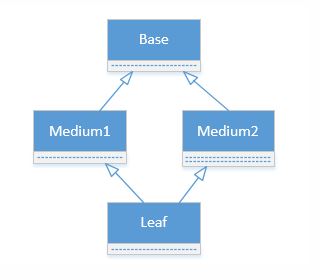super函数用来解决钻石继承。
一、python的继承以及调用父类成员
父类:
class Base(object): def __init__(self): print("base init.")
普通方法调用父类:
class Leaf(Base): def __init__(self): Base.__init__(self) print("Leaf init.")
super方法调用父类:
class Leaf(Base): def __init__(self): super(Leaf, self).__init__() print("Leaf init.")
二、钻石继承

使用普通方法调用父类,base类会初始化2次。用super解决这个问题。
class Base(object): def __init__(self): print("Base init") class Medium1(Base): def __init__(self): super(Medium1, self).__init__() print("Medium1 init") class Medium2(Base): def __init__(self): super(Medium2, self).__init__() print("Medium2 init") class Leaf(Medium1, Medium2): def __init__(self): super(Leaf, self).__init__() print("Leaf init") leaf = Leaf()
三、super工作原理
要理解super的原理,就要先了解mro。mro是method resolution order的缩写,表示了类继承体系中的成员解析顺序。在python中,每个类都有一个mro的类方法。我们来看一下钻石继承中,Leaf类的mro是什么样子的:
print(Leaf.mro()) [<class '__main__.Leaf'>, <class '__main__.Medium1'>, <class '__main__.Medium2'>, <class '__main__.Base'>, <class 'object'>]
可以看到mro方法返回的是一个祖先类的列表。Leaf的每个祖先都在其中出现一次,这也是super在父类中查找成员的顺序。
通过mro,python巧妙地将多继承的图结构,转变为list的顺序结构。super在继承体系中向上的查找过程,变成了在mro中向右的线性查找过程,任何类都只会被处理一次。
通过这个方法,python解决了多继承中的2大难题:
1. 查找顺序问题。从Leaf的mro顺序可以看出,如果Leaf类通过super来访问父类成员,那么Medium1的成员会在Medium2之前被首先访问到。如果Medium1和Medium2都没有找到,最后再到Base中查找。
2. 钻石继承的多次初始化问题。在mro的list中,Base类只出现了一次。事实上任何类都只会在mro list中出现一次。这就确保了super向上调用的过程中,任何祖先类的方法都只会被执行一次。
四、super的使用方法
用法一、super(type, obj)
当我们在Leaf的__init__中写这样的super时:
class Medium1(Base): def __init__(self): super(Medium1, self).__init__() print("Medium1 init")
super(Leaf, self).__init__()的意思是说:
- 获取self所属类的mro, 也就是[Leaf, Medium1, Medium2, Base]
- 从mro中Leaf右边的一个类开始,依次寻找__init__函数。这里是从Medium1开始寻找
- 一旦找到,就把找到的__init__函数绑定到self对象,并返回
从这个执行流程可以看到,如果我们不想调用Medium1的__init__,而想要调用Medium2的__init__,那么super应该写成:super(Medium1, self)__init__()
用法二、super(type, type2)
class Leaf(Medium1, Medium2): def __new__(cls): obj = super(Leaf, cls).__new__(cls) print("Leaf new") return obj
super(Leaf, cls).__new__(cls)的意思是说:
- 获取cls这个类的mro,这里也是[Leaf, Medium1, Medium2, Base]
- 从mro中Leaf右边的一个类开始,依次寻找__new__函数
- 一旦找到,就返回“ 非绑定 ”的__new__函数
由于返回的是非绑定的函数对象,因此调用时不能省略函数的第一个参数。这也是这里调用__new__时,需要传入参数cls的原因,同样的,如果我们想从某个mro的某个位置开始查找,只需要修改super的第一个参数就行。